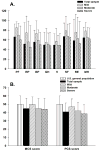Occurrence and characteristics of chronic pain in a community-based cohort of indigent adults living with HIV infection
- PMID: 21684218
- PMCID: PMC3164738
- DOI: 10.1016/j.jpain.2011.04.002
Occurrence and characteristics of chronic pain in a community-based cohort of indigent adults living with HIV infection
Abstract
Pain is common among people living with HIV/AIDS (PLWHA), but little is known about chronic pain in socioeconomically disadvantaged HIV-infected populations with high rates of substance abuse in the postantiretroviral era. This cross-sectional study describes the occurrence and characteristics of pain in a community-based cohort of 296 indigent PLWHA. Participants completed questionnaires about sociodemographics, substance use, depression, and pain. Cut-point analysis was used to generate categories of pain severity. Of the 270 participants who reported pain or the use of a pain medication in the past week, 8.2% had mild pain, 38.1% had moderate pain, and 53.7% had severe pain. Female sex and less education were associated with more severe pain. Depression was more common among participants with severe pain than among those with mild pain. Increasing pain severity was associated with daily pain and with chronic pain. Over half of the participants reported having a prescription for an opioid analgesic. Findings from this study suggest that chronic pain is a significant problem in this high risk, socioeconomically disadvantaged group of patients with HIV disease and high rates of previous or concurrent use of illicit drugs.
Perspective: This article presents epidemiological data showing that unrelieved chronic pain is a significant problem for indigent people living with HIV. Participants reported pain severity similar to those with metastatic cancer. Despite high rates of substance use disorders, approximately half received prescriptions for opioid analgesics, although few for long-acting agents.
Copyright © 2011 American Pain Society. Published by Elsevier Inc. All rights reserved.
Conflict of interest statement
The authors report no conflicts of interest.
Figures


References
-
- Abrams DI, Jay CA, Shade SB, Vizoso H, Reda H, Press S, Kelly ME, Rowbotham MC, Petersen KL. Cannabis in painful HIV-associated sensory neuropathy: a randomized placebo-controlled trial. Neurology. 2007;68:515–21. - PubMed
-
- Al-Delaimy W, Messer K, Pierce J, Trinidad D, White M. Technical Report on Analytic Methods and Approaches Used in the 2005 California Tobacco Survey Analysis. La Jolla, CA: University of California, San Diego; 2007.
-
- American Psychiatric Association. Diagnostic and Statistical Manual of Mental Disorders. 4. Washington, DC: American Psychiatric Association; 2000. revised.
-
- Beck AT, Steer RA, Brown GK. BDI-II Beck Depression Inventory Manual. San Antonio, TX: The Psychological Corp, Harcourt Brace & Company; 1996.
Publication types
MeSH terms
Substances
Grants and funding
LinkOut - more resources
Full Text Sources
Medical
Miscellaneous

